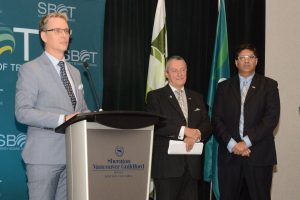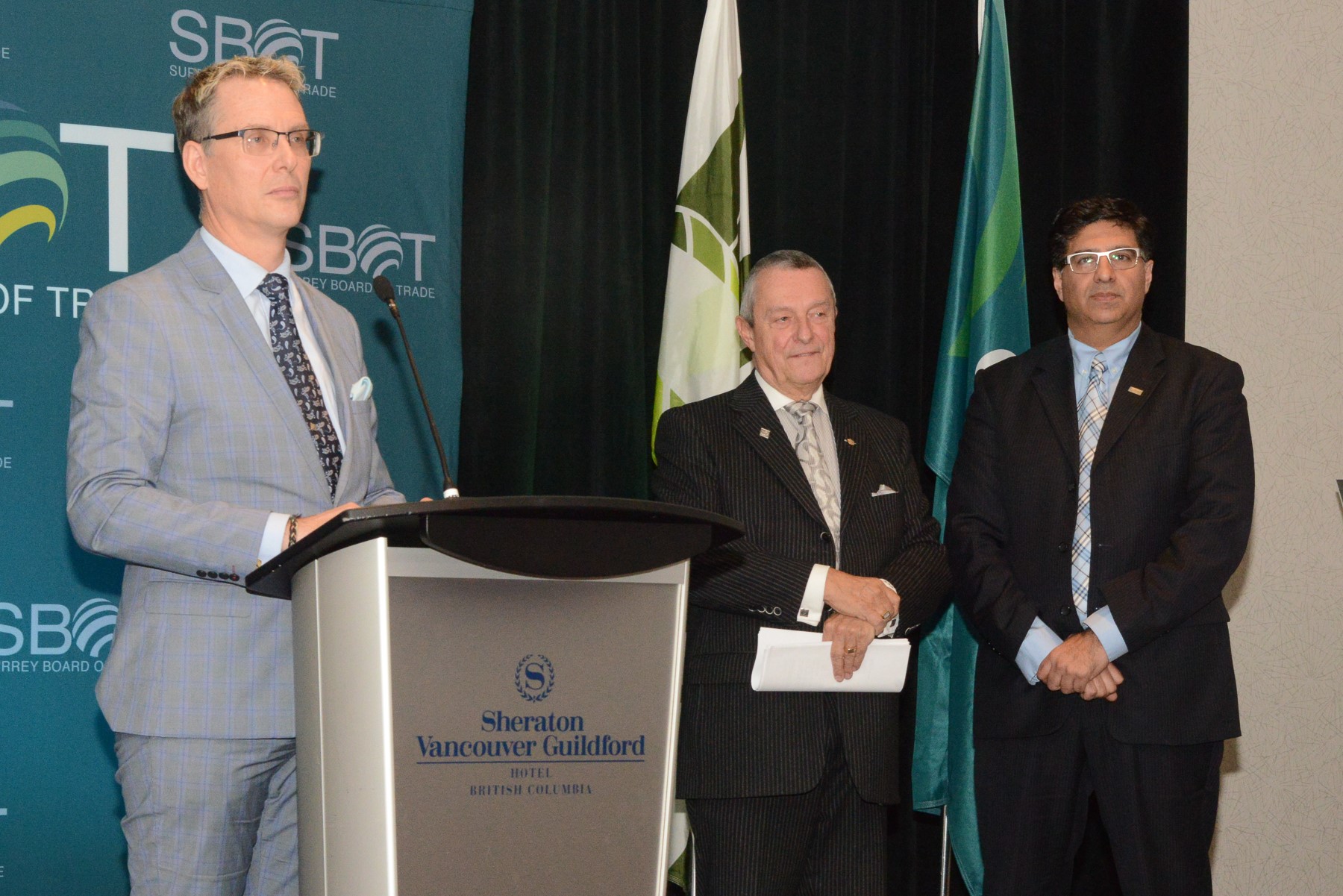
Surrey: The City of Surrey in the person of Councillor Tom Gill, and TransLink Minister Peter Fassbender, came together this week at the Surrey Board of Trade Transportation Leadership Lunch, to review and discuss plans for development of transportation and rapid transit for Surrey and the South Fraser region.
In the audience were a number of key people including Kevin Desmond, CEO of TransLink and TransLink Board member, former Surrey City Manager, Murray Dinwoody. There was also representation from UBER and the City of Abbotsford ‘s International Airport with Mayor Henry Braun and Parm Sidhu, the Airport General Manager.
Tom Gill set the scene with the scenario that in the next 25 years, Surrey’s population will grow by 50%, two-hundred and fifty thousand people.
“Transportation plans focus on community safety, sustainability, economic development and efficient movement of goods, personal mobility and transportation choices,” said Gill. “All of these plans are tied with how our city will move into the future. One of the key success factors will be the introduction of Surface Light Rail and, Mister Minister, I will not define what surface light rail means today in terms of height or elevation but certainly I wanted to give my preference and that would be at grade.”
Gill said that “surface level urban light rail is the key to creating connected complete and livable space that interfaces with residential living, employment centres and retail shopping and restaurants.”
Gill described the first phase of the LRT as the ten kilometre “L-Line” from Guildford Town Centre along 104th to City Centre, and from City Centre along King George Boulevard to Newton Town centre. Phase two, the Fraser Highway line, will connect Surrey City Centre to Fleetwood Town Centre to the Clayton neighbourhood, the Township of Langley and the City of Langley. When the 27 km network is finished it will provide transit access to one hundred ninety-five thousand people.
“The Mayors’ Council approved the improvements that we will see starting in 2017,” said Clr Gill, “including increased bus and HandiDART service, increases in rail service, pre-work and consultation on Surrey Light Rail, new money for improvements on the major road networks and expansion of the cycling and walking networks.”
Out of the $370 million from the federal government and the province’s $244 million, $58 million is for Surrey LRT: $20 million for planning and design; $17 million for new bus exchanges at Guildford, and $21 million for road improvements.
Gill said that 2017 will see secure funding for design, 2018 procurement will be well underway with early works, and by 2019 to 2020 “hopefully we’ll have full construction.”
When Peter Fassbender took the microphone, he immediately reaffirmed the province’s commitment to the “L Line” in the City of Surrey.
“Not just because Surrey wants it, but because we recognize the values of livability, walkability and access that it brings along 104th Avenue and along the King George Boulevard corridor,” the minister said. “The province must build, not just in Metro Vancouver, a system that moves people, goods and services and builds healthy communities. One of the priorities is increasing density along rapid transit, and transit corridors, not just along the rail lines but throughout the communities where we know we have dedicated transit corridors. Building density provides more supply which is critical to the province and to this region and allows for higher affordability for people which is a huge issue that you are more than aware of. Transportation is one of the key elements to building healthy communities to ensure economic growth and ensure we have communities where people can walk to transit options where they don’t even need a car and will rent on the occasion when they do.”
Referring to their ten-year transportation strategy ‘BC On The Move’ he acknowledged the growing transportation pressure on Abbotsford and the growing value of Abbotsford Airport as an economic driver for the region and the province, not only moving passengers but also moving goods and services as part of that long term strategy.
Fassbender also turned to ride-sourcing alternatives, restating the need for a made in BC solution, taking the necessary time to consult broadly across the province, saying they need to create an environment that “the existing industry, the taxi companies, the drivers, the people that have invested in their businesses, can be protected by creating a fair and level playing field for everyone who wants to move people around.”
“The public wants more options and choice, to get on buses or rapid transit, to find other ride sharing opportunities,” said Fassbender, “but we watched other jurisdictions that moved quickly and then had to back off because they didn’t think about the implications. We want to do it right.”
He also said that public safety would be paramount in requiring licensing and criminal records checks for drivers, and that the appropriate insurance would be in place to protect consumers.
The minister also reiterated that densification along corridors was happening along the millennium line, particularly in the Brentwood area. He said that those developments should be contributing to building rapid transit south of the Fraser because the South of the Fraser region contributed through taxes as they did, to build the line that Burnaby is now benefiting from.
“I believe as someone who has lived south of the Fraser, we’ve contributed for a long time to build the system that we have,” said Fassbender. “It was necessary to do that, but we’re now at the phase where Surrey and the growth we’re seeing here and in the Langley, in Abbotsford, in the northeast sector, require we work together to contribute to provide the transportation options in all of those communities.”
The minister added it was critical that the Mayor’s Council and the Board keep working on mobility pricing to come up with a single definition.













